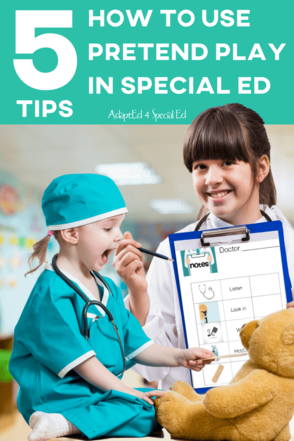Every educator has heard of the importance of play in early childhood. Play and language are so interwoven that they become mirrors of each other.
Play exposes kids to social scenarios, functional life skills, problem-solving. . . the list is endless.
But why, then, is play so difficult to teach?
As a school SLP I visit a wide variety of special education classrooms where play usually looks like THIS: solitary play with an object (and let’s be real . . . 90% of the time it’s a tablet).
While we might call it “playing” on the iPad, the truth is that there is very little to no play being developed at all.
It’s up to us to shape play for our students.
A common misconception is that when students aren’t engaging in play it means that they don’t WANT to. In reality, it actually might mean that they just don’t know HOW to play. That’s where we come in as educators.
Here are 5 tried and true tips for increasing your students’ ability to play and interact . . . INDEPENDENTLY :)
1) Get Involved
That’s right- be prepared to get down on the floor. Shuffle yourself into that corner of the play kitchen where you never thought you could fit.
Do whatever it is you need to in order to get yourself back into the mindset of a kid (I just remember squishing my foot through a mud pie and letting the mud ooze between my toes- then I’m right back to being 7 years old . . . TMI? 😂).
Do whatever it takes to become a kid again, because your students need you to show them how it’s done.
If our littles knew how to play then they would already be doing it. But they aren’t- - - which means they need a model.
They need an adult to show them the steps.
With repetition, they can learn how to serve up a cup of “coffee” and pretend that it’s hot. (“Ouch! It spilled!”)
They can learn how to take care of themselves and others (Peeeeee-yoooooo! Baby needs a diaper change!”)
Watching others play encourages them to play and gives them an idea of what to expect.
2) Play is Play (Not WORK)
Play is only functional to a student if they enjoy it.

As kids we chose activities that we liked and, even though our little minds were busy learning, we never knew that our play was anything more than good fun.
One of the common downfalls of trying to TEACH play is that we can end up turning it into work.
Some simple ways around this are to always stay animated (keep the kids laughing and they will never stop wanting to engage) and to keep supported play to a natural time limit.
If you see your student is losing interest or needs a break (that was a lot of language you just got out of them during playing “house”!) then let them have a moment to relax and regroup.
Keep it lighthearted and they will come back for more as soon as they are ready. Lighthearted means that your demeanor and your voice portray fun, not WORK.
Keeping the play child-led can be an easy way to ensure they are engaged. Let the child choose the type of play they are most interested in.
Aaaaaaand be okay with it when they change their mind five minutes in! 😂
3) Keep it Simple, Baby!
So we know from our childhoods that there are about a million and twelve ways that you can play with a given toy.
A doll can be your baby . . . or it can be the child you rescued from the jungle just as it was about to be eaten by a tiger!
But our students in special education need to start slow.
Repetition of simple (but fun!) activities is really key.
We like to start with really functional games. Take food play, for instance.
It just takes an empty bowl and a spoon to create hilarity- practice using different facial expressions every time your student “feeds you” a bite.
First time it's absolutely delicious,
second time it’s so disgusting that you pass out.
Keep the kids engaged in SIMPLE repetition.
The more they practice the more they will remember when they encounter the same toys again.
4) Use VISUALS
When it comes to special education we use visuals for EVERYTHING. And there’s a reason for that.
It helps our students comprehend and become independent with the task that’s in front of them.
So why use visuals for math time, but leave the students without support when it comes to play?
Well, I say that play should involve as many functional visuals as possible. So what’s a functional visual? It’s a visual support that doesn’t get in the way of the play itself.
Functional visuals allow students to engage in play tasks without making them feel like they are working.
AdaptEd believes in making visuals that aid students in playing independently while being carefully disguised as regular play items.
For example, we don’t expect our students to remember exactly what to do when they are presented with a doctor’s kit. So instead, we allow them to have “Doctor’s Notes” as part of their doctor get up.
We model the natural action of checking off the notes every time the doctor completes a task ( And man, do they LOOOVE hearing themselves say “check” as they do it).
5) Share Progress
Our students are getting lots of praise for the activities they do throughout their day (as they should!)
Make sure that play is one of those areas you are praising.
Here at AdaptEd we like to keep simple notes about the play we observe.
This allows us to approach a student afterwards and give them specific feedback: “Wow, I really liked the way you made the car go ‘Vroooom’ today!” or “You played with Jessica today and it looked fun!”
Not only does this serve to congratulate students, but it also gives them the knowledge that they were successful.
Whenever possible (we know - - - you are BUSY!), catching a quick video of a student engaged in any stage of successful play can be soooooo rewarding!
We all have our smartphone or a device nearby, so let’s use them!
Make sure you have permission from a parent to get any photos or video (Psssst . . . It may help to explain how videos you capture can serve as video models for the student!).
So there you have it- some of our favorite simple tips for teaching play skills!
If you’d like to simplify the process, check out these new materials from AdaptEd that are aimed specifically at increasing play skills.
They include those visuals that we were talking about earlier and they have made a WORLD of change for our students. Not to mention- these activities have really gotten the language flowing.
As soon as we enter the classroom with our play doctor kit we hear a chorus of “My turn!” “You are sick!” “Hot or cold?” “Put on bandaid!”
Hey. it just might bring out the kid in YOU too :)
XOXO,
Meg, Your AdaptEd SLP
PS -We've got some play visuals you can get here!





